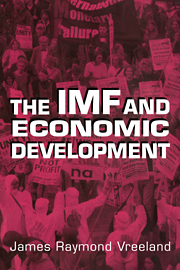Book contents
- Frontmatter
- Contents
- List of Tables and Figures
- Acknowledgements
- 1 Introduction
- 2 Analytically Significant Cases
- 3 An Analytical Approach to the Politics of IMF Agreements
- 4 Testing the Selection Story
- 5 The Effect of IMF Programs on Economic Growth
- 6 Distributional Consequences of IMF Programs
- 7 Conclusions
- Appendix 1 Variables Used in This Study
- Appendix 2 Country-Years in Samples
- References
- Index
3 - An Analytical Approach to the Politics of IMF Agreements
Published online by Cambridge University Press: 08 January 2010
- Frontmatter
- Contents
- List of Tables and Figures
- Acknowledgements
- 1 Introduction
- 2 Analytically Significant Cases
- 3 An Analytical Approach to the Politics of IMF Agreements
- 4 Testing the Selection Story
- 5 The Effect of IMF Programs on Economic Growth
- 6 Distributional Consequences of IMF Programs
- 7 Conclusions
- Appendix 1 Variables Used in This Study
- Appendix 2 Country-Years in Samples
- References
- Index
Summary
The narratives in the previous chapter illustrate that, although some governments enter into IMF agreements because they need a loan, they also have an ideal level of conditions they want to have imposed upon them as part of the IMF agreement. Some governments, like Tanzania 1976 want a loan and only weak conditions imposed. Others want both a loan and conditions, as seen in Tanzania 1986 and possibly Nigeria 1983. Still others, like Uruguay 1990, do not need a loan and enter into the IMF agreement purely for the conditions.
Why would a government want conditions to be imposed? I have argued that by entering into an IMF agreement, a reform-oriented executive makes it more costly for domestic actors with veto power over policy (“veto players”) to reject his preferred policies. Rejecting the IMF is costly – to the executive as well as to potential opponents – because it limits access to IMF credit (Schadler 1995) and sends negative signals to creditors (Callaghy 1997, 2002; Aggarwal 1996) and investors (Stone 2002; Edwards 2000). Callaghy explains that debt negotiations are virtually impossible with a canceled IMF agreement. Regarding investors, Stone (as noted before, 2000: 2), contends, “When the Fund negotiates a stabilization program with a government that imposes policy conditions, it creates a focal point for investors to coordinate their expectations.” The country as a whole may suffer if the IMF is rejected.
- Type
- Chapter
- Information
- The IMF and Economic Development , pp. 53 - 82Publisher: Cambridge University PressPrint publication year: 2003



